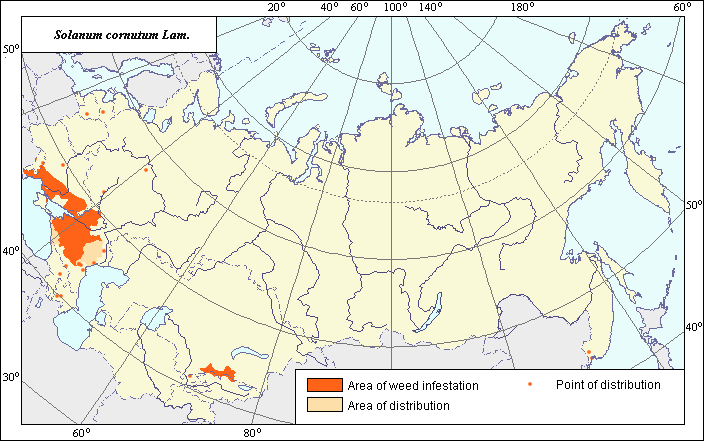Weeds
Area of distribution and weediness of Solanum cornutum Lam.
 Object description Download GIS-layers
Object description Download GIS-layers
Authors:
Scientist - S.Yu. Larina,GIS-specialist - I.A. Budrevskaya.
Date of creation:
06.12.2004.Scale:
1:20,000,000.Accuracy of map:
Map was created based on materials of maps of natural scale 1:5,000,000 - 1: 20,000,000.Projection:
"Alber's Equal Area Conic for the USSR" 9, 1001, 7, 100, 0, 44, 68, 0, 0.Basic content:
Vector map. Area of distribution is shown by polygon (main distribution) and points (sporadic distribution). Zone of weediness is shown by polygon.Accuracy of classifier:
Within the weed area of Solanum cornutum the zones of weediness were established according to criteria of occurrence (% of fields where this species is found) and abundance [expressed as projective cover of this species in the field (in % to the field area) (Tanskii et al., 1998)], where the occurrence of this species exceeded 10% and its abundance (projective cover) exceeded 5%, which led to yield decreases of more than 0.2-0.3 tons per hectare (Samus, 1966).Method of map production:
The areas of distribution and weediness of Solanum cornutum were established according to analysis of open-published maps and literature. The area of species distribution within Russia is based on the map from the publication of G.P.Moskalenko (2001); within Ukraine it was established according to V.V.Protopopova (1973), with specification according to V.Omelyuta, et al. (2001). The area of distribution within Kazakhstan is outlined according to V.Ya.Maryushkina, et al. (1990). Zone of weediness of S.cornutum is established within Russia according to G.P.Moskalenko (2003), within Ukraine according to V.Omelyuta, et al. (2001); within Kazakhstan zone of weediness is depicted according to the Report on plant protection by Ministry of Agriculture of Republic of Kazakhstan (2002), and coordinated with the limits of arable lands. Sporadic distribution of S.cornutum was depicted in the European part of Russia based on E.A.Borisova (1993) and V.D.Bochkin, et al. (1996); in the Far East according to T.I.Nechayeva (1985) and S.S.Kharkevich (1991); within North Caucasus and Transcaucasia based on A.A.Grossgeim (1967), G.P.Moskalenko (2001), P.L.Lvov (1979), A.P.Khokhryakov & M.T.Mazurenko (1972), V.V.Nikitin (1983); in Ukraine according to V.V.Protopopova (1973); in Central Asia based on V.V.Nikitin (1983), in Moldavia based on V.V.Nikitin (1983) and M.V.Myrza (1991), within Baltic States according to Z.A.Gudzhinskas (1989) and L.V.Tabaka, et al. (1988).Reference citations:
Basset, I.J. & Munro, D.B. 1986. The biology of Canadian weeds. 78. Solanum carolinense L. and Solanum rostratum Dunal. Canadian Journal of Plant Sciences. 66(10): 977-91.Bochkin, V.D., Klinkova, G.Yu., Sagalayev, V.A., Skvortsov, A.K. & Shantser, I.A. About findings of new and rare plants for Lower Volga region. 1996. Bulletin MOIP. Sect.biol. 101(5): 87-91. (in Russian).
Borisova, E.A. 1993. Additions to the adventive flora of Ivanovo region. Bulletin MOIP. Sect.biol. 98(6): 114-7. (in Russian).
Chebotar, A.A., ed. 1989. Plants of steppes and limestone slopes, and weeds. Kishinev: Shtiintsa. 304 p. (in Russian).
Grossgeim, A.A. 1967. Flora of the Caucasus. V.7. Leningrad: Nauka. 894 p. (in Russian).
Gudzhinskas, Z.A. 1989. New adventive plant species for Lithuanian flora. Botanicheskii zhurnal. 74(10): 1499-1504. (in Russian).
Kharkevich, S.S., ed. 1991. Vascular plants of the Soviet Far East. V.5. Leningrad: Nauka. 390 p. (in Russian).
Khokhryakov, A.P. & Mazurenko, M.T. 1972. Comparative analysis of adventive wild flora in Kolkhida. Bulletin MOIP. Sect.biol. 77(1): 128-138. (in Russian).
Lvov, P.L. 1979. About new floristic findings in Dagestan. Botanicheskii zhurnal. 64(2): 245-6. (in Russian).
Maltsev, A.I. 1962. Weed vegetation of the USSR and measures of its control. Leningrad-Moscow: Selkhozizdat. 272 p. (in Russian).
Maryushkina, V.Ya., Didyk, L.G., Kozeko, V.G. & Kayutkina, T.M. 1990. Manual on quarantine weeds. Kiev: Urozhai. 96 p. (in Russian).
Ministry of Agriculture of Republic of Kazakhstan. 2002. Report on plant protection. Republic of Kazakhstan, Astana: www.minagri.kz (in Russian).
Moskalenko, G.P. 2001. Quarantine weeds of Russia. Moscow: Rosgoskarantin. 280 pp. (in Russian).
Moskalenko, G.P. 2003. Buffalo bur. Zashchita rastenii 4: 42-4. (in Russian).
Myrza, M.V. 1991. About some rare and adventive plants in Moldavia. Botanicheskii zhurnal. 76(1): 129-134. (in Russian).
Nechaeva, T.I. 1985. The additions to the flora of Vladivostok and its environs. In: Grubov, V.I., ed. News of systematization of higher plants. V.22. Leningrad: Nauka. p.257-61. (in Russian).
Nikitin, V.V. 1983. Weed plants of the USSR flora. Leningrad: Nauka. 454 p. (in Russian).
Omelyuta, V., Ustinov, I. & Ustinova, A. 2001. Quarantine pests, diseases and weeds. In: Propozitsiya 6: 136 : http://www.propozitsiya.com (in Ukrainian).
Protopopova, V.V. 1973. Adventive plants in forest-steppe and steppe of Ukraine. Kiev: Naukova Dumka. 192 p. (in Ukrainian).
Samus, V.I. 1966. Biology of buffalobur and its control measures in Krasnodar Territory. Abstract of dissertation for candidate of agricultural sciences. Krasnodar: Kuban agricultural institute. 19 p. (in Russian).
Shishkin, B.K. & Bobrov, E.G., ed. 1955. Flora of the USSR. V.22. Moscow-Leningrad: AN SSSR. 861 p. (in Russian).
Tabaka, L.V., Gavrilova, G.B. & Fatare, I.Ya. 1988. Flora of vascular plants of Latvian SSR. Riga: Zinatne. 196 p. (in Russian).
Tanskii, V.I., Levitin, M.M., Ishkova, T.I. & Kondratenko, V.I. 1998. Phytosanitary diagnostics in integrated management of cereals. In: Novozhilov K.V., ed. Compendium of methodical recommendations in plant protection. Sankt-Petersburg: VIZR. p.5-55. (in Russian).
Ulyanova, T.N. 1998. Weed plants in flora of Russia and other CIS countries. St.Petersburg: VIR. 343 p. (in Russian).
Right and copyright:
All rights reserved.Copyright 2004© S.Yu.Larina & I.A.Budrevskaya.
The image taken from the book of A.I.Maltsev (1962).

